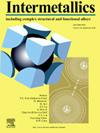Al0.5CoCrFeNi-yNb high-entropy alloys via spark plasma sintering: Microstructural evolution, property enhancement, and wear resistance optimization
IF 4.3
2区 材料科学
Q2 CHEMISTRY, PHYSICAL
引用次数: 0
Abstract
This study explores the effects of Nb doping (0–9 wt%) on Al0.5CoCrFeNi HEAs via mechanical alloying-spark plasma sintering (MA-SPS). Nb addition drives the formation of a hexagonal Laves phase (Co(Ni, Fe, Cr)2Nb), with its volume fraction increasing from 0.042 % (1Nb) to 20.748 % (9Nb) and the face-centered cubic (FCC) phase decreasing from 84.8 % to 66.1 %. Thermodynamic stability of the Laves phase is confirmed via the average d-orbital energy level criterion (——Md > 0.9866) and CALPHAD simulations. Mechanical properties are significantly enhanced: Vickers hardness increases linearly from 275.4 to 453.3 HV3, and yield strength from 520.6 to 1092.6 MPa, attributed to synergistic strengthening from Nb-induced lattice distortion, Laves phase precipitation, and grain refinement. Plasticity decreases from 28 % to 5.6 % due to the brittle Laves phase. Tribological tests reveal that the 9Nb alloy exhibits a 71 % lower wear rate (8.61 × 10−5 vs. 2.96 × 10−4 mm3/(N·m)) owing to its high hardness, wear-resistant Laves phase, and dense Nb-stabilized oxide films (NbO/Nb2O5), while maintaining high indentation fracture toughness (70.8 MPa√m) and compactness (>99 %). The MA-SPS process enables a controlled transition from a dual-phase (FCC + BCC) to a triphasic (FCC + BCC + Laves) microstructure, achieving an optimal balance of strength, toughness, and wear resistance. This work provides a quantitative framework for designing high-performance HEAs with tailored properties for demanding wear-resistant engineering applications.
火花等离子烧结Al0.5CoCrFeNi-yNb高熵合金:组织演变、性能增强和耐磨性优化
本研究通过机械合金化-火花等离子烧结(MA-SPS)技术探讨了Nb掺杂(0-9 wt%)对Al0.5CoCrFeNi HEAs的影响。Nb的加入促进了六方Laves相(Co(Ni, Fe, Cr)2Nb)的形成,其体积分数从0.042% (1Nb)增加到20.748% (9Nb),面心立方相(FCC)从84.8%减少到66.1%。Laves相的热力学稳定性通过平均d轨道能级判据(—Md >;0.9866)和CALPHAD模拟。力学性能显著增强:维氏硬度从275.4 HV3线性增加到453.3 HV3,屈服强度从520.6 MPa线性增加到1092.6 MPa,这是由于nb诱导的晶格畸变、Laves相析出和晶粒细化的协同强化。由于脆性的Laves相,塑性从28%下降到5.6%。摩擦学试验表明,9Nb合金具有较高的硬度、耐磨的Laves相和致密的铌稳定氧化物膜(NbO/Nb2O5),在保持较高的压痕断裂韧性(70.8 MPa / m)和致密性(> 99%)的同时,其磨损率降低了71% (8.61 × 10−5 vs 2.96 × 10−4 mm3/(N·m))。MA-SPS工艺实现了从双相(FCC + BCC)到三相(FCC + BCC + Laves)微观结构的可控过渡,实现了强度、韧性和耐磨性的最佳平衡。这项工作为设计高性能HEAs提供了一个定量框架,为苛刻的耐磨工程应用提供了量身定制的性能。
本文章由计算机程序翻译,如有差异,请以英文原文为准。
求助全文
约1分钟内获得全文
求助全文
来源期刊

Intermetallics
工程技术-材料科学:综合
CiteScore
7.80
自引率
9.10%
发文量
291
审稿时长
37 days
期刊介绍:
This journal is a platform for publishing innovative research and overviews for advancing our understanding of the structure, property, and functionality of complex metallic alloys, including intermetallics, metallic glasses, and high entropy alloys.
The journal reports the science and engineering of metallic materials in the following aspects:
Theories and experiments which address the relationship between property and structure in all length scales.
Physical modeling and numerical simulations which provide a comprehensive understanding of experimental observations.
Stimulated methodologies to characterize the structure and chemistry of materials that correlate the properties.
Technological applications resulting from the understanding of property-structure relationship in materials.
Novel and cutting-edge results warranting rapid communication.
The journal also publishes special issues on selected topics and overviews by invitation only.
 求助内容:
求助内容: 应助结果提醒方式:
应助结果提醒方式:


